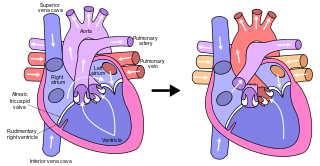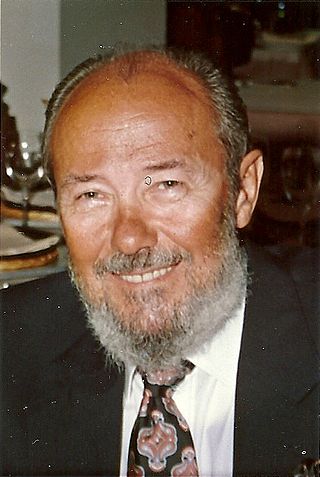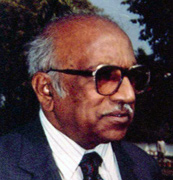
Axel Haverich (born March 9, 1953) is a German cardiac surgeon.

Axel Haverich (born March 9, 1953) is a German cardiac surgeon.
Born in Lemgo, Haverich completed his Abitur at the Barntrup Gymnasium in 1972. He studied medicine at the Medizinische Hochschule Hannover (MHH) and graduated in 1978. [1] One year later he received his M.D. title (promotion). During his work as an assistant surgeon he spend time as a research assistant at the Department of Cardiovascular Surgery of the Stanford University. [1] In 1985 he became Senior Surgeon (Oberarzt) at the Clinic for Cardiac, Thoracic, and Vascular Surgery at the MHH. His habilitation was completed in 1987. From 1993 to 1996 he worked as the Director for heart and vascular surgery at the Kiel University. [1] In 1996 he returned to the MHH as medical director of Cardiac, Thoracic, Transplant and Vascular Surgery. [2]
Much of Haverich’s work is focused on tissue engineering and development of implantable organs, specifically for the heart and vascular system. In 2006 his team reported on the transplantation of heart valves in two children (11 and 13 years old) done in 2002; the heart valves originated from donors, were decellularized, and then reseeded with autologous stem cells so that they would continue to grow. [3] Haverich's aim is eventually to rebuild the heart by tissue engineering "from ourselves". [4]
In 1996 Haverich founded the Leibniz Research Laboratories for Biotechnology and Artificial Organs (LEBAO) to develop bioengineered tissue for the heart. [4] In 2006 Haverich founded a private company, Corlife, to produce decellularized heart halves.
In 2017 Haverich presented a new hypothesis about the pathogenesis of arteriosclerosis. [5] While the potential role of infection and inflammation had been discussed for decades, Haverich noted that only specific arteries were subject to development of arteriosclerotic plaques. He postulated that the formation of plaques is not from inside the vessel, but the result of inflammation of the feeding vessels (vasa vasorum) of arteries that becoming inflamed compromising the integrity of the arterial wall. He noted that arteries with thin walls not having vasa vasorum do not develop arteriosclerosis. He postulated that the damage by inflamed vasa vasorum leads to cell death within the wall and subsequent plaques formation. Vasa vasorum inflammation can be caused by viruses, bacteria, and fine dust among others. According to his view this concept conforms to observations that cardiac infarctions are more common when influenza has occurred or fine particles have been inhaled. [6]
(selection)

The aorta is the main and largest artery in the human body, originating from the left ventricle of the heart, branching upwards immediately after, and extending down to the abdomen, where it splits at the aortic bifurcation into two smaller arteries. The aorta distributes oxygenated blood to all parts of the body through the systemic circulation.

An artery is a blood vessel in humans and most other animals that takes oxygenated blood away from the heart in the systemic circulation to one or more parts of the body. Exceptions that carry deoxygenated blood are the pulmonary arteries in the pulmonary circulation that carry blood to the lungs for oxygenation, and the umbilical arteries in the fetal circulation that carry deoxygenated blood to the placenta. It consists of a multi-layered artery wall wrapped into a tube-shaped channel.

Atherosclerosis is a pattern of the disease arteriosclerosis, characterized by development of abnormalities called lesions in walls of arteries. This is a chronic inflammatory disease involving many different cell types and driven by elevated levels of cholesterol in the blood. These lesions may lead to narrowing of the arterial walls due to buildup of atheromatous plaques. At the onset there are usually no symptoms, but if they develop, symptoms generally begin around middle age. In severe cases, it can result in coronary artery disease, stroke, peripheral artery disease, or kidney disorders, depending on which body part(s) the affected arteries are located in the body.

Ischemia or ischaemia is a restriction in blood supply to any tissue, muscle group, or organ of the body, causing a shortage of oxygen that is needed for cellular metabolism. Ischemia is generally caused by problems with blood vessels, with resultant damage to or dysfunction of tissue i.e. hypoxia and microvascular dysfunction. It also implies local hypoxia in a part of a body resulting from constriction.
Cardiothoracic surgery is the field of medicine involved in surgical treatment of organs inside the thoracic cavity — generally treatment of conditions of the heart, lungs, and other pleural or mediastinal structures.

Cardiac surgery, or cardiovascular surgery, is surgery on the heart or great vessels performed by cardiac surgeons. It is often used to treat complications of ischemic heart disease ; to correct congenital heart disease; or to treat valvular heart disease from various causes, including endocarditis, rheumatic heart disease, and atherosclerosis. It also includes heart transplantation.

The Fontan procedure or Fontan–Kreutzer procedure is a palliative surgical procedure used in children with univentricular hearts. It involves diverting the venous blood from the inferior vena cava (IVC) and superior vena cava (SVC) to the pulmonary arteries. The procedure varies for differing congenital heart pathologies. For example, in tricuspid atresia, the procedure can be done where the blood does not pass through the morphologic right ventricle; i.e., the systemic and pulmonary circulations are placed in series with the functional single ventricle. By contrast, in hypoplastic left heart syndrome, the heart is more reliant on the more functional right ventricle to provide blood flow to the systemic circulation. The procedure was initially performed in 1968 by Francis Fontan and Eugene Baudet from Bordeaux, France, published in 1971, simultaneously described in July 1971 by Guillermo Kreutzer from Buenos Aires, Argentina, presented at the Argentinean National Cardilogy meeting of that year and finally published in 1973.

Vasa vasorum are networks of small blood vessels that supply the walls of large blood vessels, such as elastic arteries and large veins.
Aortic valve replacement is a cardiac surgery procedure whereby a failing aortic valve is replaced with an artificial heart valve. The aortic valve may need to be replaced because of aortic regurgitation, or if the valve is narrowed by stenosis.

The Norwood procedure is the first of three palliative surgeries for patients with hypoplastic left heart syndrome (HLHS) and other complex heart defects with single ventricle physiology intended to create a new functional single ventricle system. The first successful Norwood procedure involving the use of a cardiopulmonary bypass was reported by Dr. William Imon Norwood, Jr. and colleagues in 1981.

Åke Senning was a Swedish cardiac surgeon who worked at University Hospital of Zürich from 1961 until his retirement in 1985.

Marian Ion Ionescu was a Romanian-born British cardiac surgeon. His interest in heart surgery covered several aspects of this specialty. He was an inventor of surgical devices, mostly artificial heart valves, a scientist in the broad term and a medical educator. Ionescu died on 12 October 2023, at the age of 94.
Minimally invasive cardiac surgery, encompasses various aspects of cardiac surgical procedures that can be performed with minimally invasive approach either via mini-thoracotomy or mini-sternotomy. MICS CABG or the McGinn technique is heart surgery performed through several small incisions instead of the traditional open-heart surgery that requires a median sternotomy approach, and can be performed in patients with multivessel coronary artery disease. MICS CABG is a beating-heart multi-vessel procedure performed under direct vision through an anterolateral mini-thoracotomy.
Gilles Dreyfus is a French cardiac surgeon.

Nagarur Gopinath was an Indian surgeon and one of the pioneers of cardiothoracic surgery in India. He is credited with the first successful performance of open heart surgery in India which he performed in 1962. He served as the honorary surgeon to two Presidents of India and was a recipient of the fourth highest Indian civilian award of Padma Shri in 1974 and Dr. B. C. Roy Award, the highest Indian medical award in 1978 from the Government of India.

Decellularized homografts are donated human heart valves which have been modified via tissue engineering. Several techniques exist for decellularization with the majority based on detergent or enzymatic protocols which aim to eliminate all donor cells while preserving the mechanical properties of the remaining matrix.

Ischemic cardiomyopathy is a type of cardiomyopathy caused by a narrowing of the coronary arteries which supply blood to the heart. Typically, patients with ischemic cardiomyopathy have a history of acute myocardial infarction, however, it may occur in patients with coronary artery disease, but without a past history of acute myocardial infarction. This cardiomyopathy is one of the leading causes of sudden cardiac death. The adjective ischemic means characteristic of, or accompanied by, ischemia — local anemia due to mechanical obstruction of the blood supply.
In medicine, vein graft failure (VGF) is a condition in which vein grafts, which are used as alternative conduits in bypass surgeries, get occluded.
Tissue engineered heart valves (TEHV) offer a new and advancing proposed treatment of creating a living heart valve for people who are in need of either a full or partial heart valve replacement. Currently, there are over a quarter of a million prosthetic heart valves implanted annually, and the number of patients requiring replacement surgeries is only suspected to rise and even triple over the next fifty years. While current treatments offered such as mechanical valves or biological valves are not deleterious to one's health, they both have their own limitations in that mechanical valves necessitate the lifelong use of anticoagulants while biological valves are susceptible to structural degradation and reoperation. Thus, in situ (in its original position or place) tissue engineering of heart valves serves as a novel approach that explores the use creating a living heart valve composed of the host's own cells that is capable of growing, adapting, and interacting within the human body's biological system.
Uwe Klima is UAE based professor of surgery and a faculty member at the Hannover Medical School, Germany. He also is the medical and managing director at German Heart Centre, Dubai.